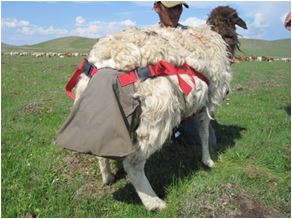Forage intake of grazing sheep in Mongolian winter grassland is 20% higher than the UNDP index
Description
Mongolia has been experiencing increases in livestock number in recent years, which in turn have led to an increased risk of climate-related disasters. To reduce the risks, it is necessary for the grassland to be managed appropriately using scientific data such as carrying capacity calculated from aboveground biomass and forage intake by animals. However, the method for calculating the index is not always clearly documented; therefore, the scope of application of the index is difficult to define. The forage intake of sheep was estimated to obtain basic information for calculating the carrying capacity of the Mongolian forest steppe and steppe grassland during autumn and the next spring.
Research data showed that aboveground biomass was lowest in February, and that the reduction rates of aboveground biomass in forest steppe and steppe from September 2011 to February 2012 were 70.9 and 82.6%, respectively. The dominant plant species were Stipa spp., Cleistogenes squarossa, and Artemisia frigid in the forest steppe, and Stipa spp., Carex pediformis, and Agropyron cristtumn. in the steppe. The body weight of sheep in forest steppe and steppe decreased by 13.6% and 8.7%, respectively, between November 2011 and February 2012 (Fig. 1). Daily fecal outputs in forest steppe and steppe were 0.475-0.665 and 0.467-0.550 kg DM, respectively. During the same period, fecal output in the forest steppe decreased significantly (Fig. 2, Table 1). Forage digestibilities determined from acid detergent lignin in pasture plants and in feces at forest steppe and steppe were 51.8-63.8 and 63.2-70.9%, respectively, and there were significant differences among seasons (Table 1). Forage intake calculated from the fecal output and forage digestibility at forest steppe and steppe were 1.10-1.89 kg DM/day (2.91-4.09% BW/day) and 1.30-1.73 kg DM/day (2.54-3.02% BW/day) (Table 1). A comparison of the forage intake during summer, autumn, winter, and spring showed experimental data values of 1.6, 1.8, 1.1, and 1.1 kg DM/day, respectively, which was 20% higher than the prevalent index data (which was determined by UNDP, 2007) for winter (February). Therefore, the carrying capacity in winter, as calculated from experimental data, is lower than the prevalent index.
In the future, it would be possible to extensively compare the carrying capacities by estimating the forage intakes on different regions and grazing environments. Forage digestibility is affected by seasonal differences and vegetation composition, and must be considered in the calculations. Also, it is recommended that feed intake expressed in terms of body weight (%BW/day) be calculated for the comparison.
Figure, table
-
Fig. 1. Seasonal changes of aboveground biomass
-
Fig. 2. Fecal bag attached to the sheep
-
Table 1. Calculation of intake and other parameters measured in forest steppe and steppe
-
- Affiliation
-
Japan International Research Center for Agricultural Sciences Crop, Livestock and Environment Division
Japan International Research Center for Agricultural Sciences Rural Development Division
- Classification
-
Administration B
- Research project
- Program name
- Term of research
-
FY2015(FY2011-FY2015)
- Responsible researcher
-
Uehara Aritsune ( Rural Development Division )
Yamasaki Seishi ( Crop, Livestock and Environment Division )
Shindo Kazumasa ( NARO Institute of Livestock and Grassland Science )
Ayush Erdenechimeg ( Mongolian State University of Agriculture )
GANBAATAR Onontuul ( Mongolian State University of Agriculture )
- ほか
- Publication, etc.
-
Uehara et al. (2015), Animal Science Journal, 86(2): 201-209
Uehara et al.(2015), Journal of Arid Land Studies, 25(2): 17-24
- Japanese PDF
-
2015_A03_A4_ja.pdf497.6 KB
2015_A03_A3_ja.pdf263.1 KB
- English PDF
-
2015_A03_A4_en.pdf306.9 KB
2015_A03_A3_en.pdf117.71 KB
- Poster PDF
-
2015_A03_poster.pdf338.21 KB

